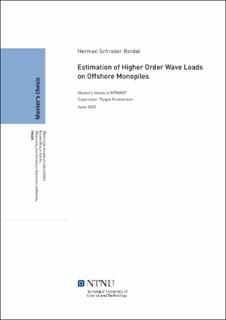| dc.contributor.advisor | Kristiansen, Trygve | |
| dc.contributor.author | Bordal, Herman Schrader | |
| dc.date.accessioned | 2021-09-21T16:28:54Z | |
| dc.date.available | 2021-09-21T16:28:54Z | |
| dc.date.issued | 2020 | |
| dc.identifier | no.ntnu:inspera:54166542:20925028 | |
| dc.identifier.uri | https://hdl.handle.net/11250/2780113 | |
| dc.description.abstract | Kristiansen and Faltinsen(2017) viste at den ikke viskøse FNV teorien over predikerer de 3 harmoniske kreftene på en vertikal sylinder i lange og steile bølger. Den analytiske løsningen er utledet ved bruk av potensial teori, og inkluderer da følgelig ikke avløsning av strømningen. KC tallet indikerer at avløsning og virvler er påvirker strømningen. For å inkludere effekten av viskøs oppførsel ble en kombinert viskøs CFD-FNV teori utledet.
Forsøk har vist tilstedeværelsen av 3D effecter. En utvidelse av 2D CFD ble utledet ved å bruke de gjenværende leddende i Navier Stokes likning, samt en antagelse om at objektet minimalt påvirker innkommende bølge. Den nyutviklede CFD-FNV teorien ga gode resultater og kunne, delvis, forklare forklare avviket mellom eksperimenter og FNV teorien.
Forsøkene utført av Kristiansen and Faltinsen(2017) ble gjenskapt for innsamling av ekstra visuell data. Spesielt fokus var viet til en vannsøyle som er observert på baksiden av sylinderen. | |
| dc.description.abstract | Kristiansen and Faltinsen (2017a) showed that the inviscid FNV theory over-predicts the third harmonic wave load on bottom fixed vertical surface-piercing cylinders for long and steep waves. The analytic solution is obtained by potential theory, which do not capture flow separation. The KC number in severe sea states indicate flow separation and viscous effects affecting the forces. The need for viscous modelling was apparent to improve existing theories. A combined viscous CFD-FNV method was derived by substituting the 2D inline force from uniform potential theory with viscous 2D CFD.
As experiments indicate 3D effects might have an impact on higher order. A 3D extension to original 2D CFD was included. The term is derived by expanding the CFD results with the remaining terms in the Navier Stokes equation, and assuming that the slender body assumption is valid. The CFD-FNV theory did improve the estimation on third harmonic loads compared to the FNV theory with fifth-order stokes wave kinematics. Forces were accurately estimated for a broad range of wave conditions. The discrepancy between the inviscid FNV theory and experiments were, partially, corrected by the combination of viscous CFD analysis and the inclusion of the newly derivated slender body term.
The experiments by Kristiansen and Faltinsen (2017a) were reconducted to get visual data of possible 3D effects. A narrow run-up at the rear of the cylinder in regular waves was observed, the phenomenon has previously been mentioned in several papers. The observation lead to an investigation of methods to describe the phenomenon, and subsequently involve the effect in the analysis. This, unfortunately, came to a halt as the project was limited by time. This is thus left for further investigation. | |
| dc.language | | |
| dc.publisher | NTNU | |
| dc.title | Estimation of Higher Order Wave Loads on Offshore Monopiles | |
| dc.type | Master thesis | |
